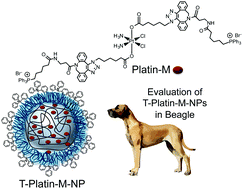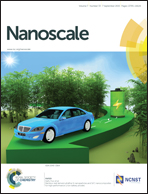Evaluation of nanoparticle delivered cisplatin in beagles†
Abstract
Intracranial neoplasia is a significant cause of morbidity and mortality in both human and veterinary patients, and is difficult to treat with traditional therapeutic methods. Cisplatin is a platinum (Pt)-containing chemotherapeutic agent approved by the Food and Drug Administration; however, substantial limitations exist for its application in canine brain tumor treatment due to the difficulty in crossing the blood-brain barrier (BBB), development of resistance, and toxicity. A modified Pt(IV)-prodrug of cisplatin, Platin-M, was recently shown to be deliverable to the brain via a biocompatible mitochondria-targeted lipophilic polymeric nanoparticle (NP) that carries the drug across the BBB and to the mitochondria. NP mediated controlled release of Platin-M and subsequent reduction of this prodrug to cisplatin allowed cross-links to be formed with the mitochondrial DNA, which have no nucleotide excision repair system, forcing the overactive cancer cells to undergo apoptosis. Here, we report in vitro effects of targeted Platin-M NPs (T-Platin-M-NPs) in canine glioma and glioblastoma cell lines with results indicating that this targeted NP formulation is more effective than cisplatin. In both the cell lines, T-Platin-M-NP was significantly more efficacious compared to carboplatin, another Pt-based chemotherapy, which is used in the settings of recurrent high-grade glioblastoma. Mitochondrial stress analysis indicated that T-Platin-M-NP is more effective in disrupting the mitochondrial bioenergetics in both the cell types. A 14-day distribution study in healthy adult beagles using a single intravenous injection at 0.5 mg kg−1 (with respect to Platin-M) of T-Platin-M-NPs showed high levels of Pt accumulation in the brain, with negligible amounts in the other analyzed organs. Safety studies in the beagles monitoring physical, hematological, and serum chemistry evaluations were within the normal limits on days 1, 7, and 14 after injection of either 0.5 mg kg−1 or 2 mg kg−1 or 2.2 mg kg−1 (with respect to Platin-M) of T-Platin-M-NPs. At all doses over the 14-day period, no neurotoxicity was observed based upon periodic neurological examinations and cerebrospinal fluid analysis. These studies demonstrated the translational nature of T-Platin-M-NPs for applications in the treatment of brain tumors.


 Please wait while we load your content...
Please wait while we load your content...